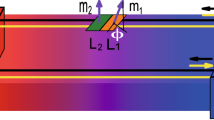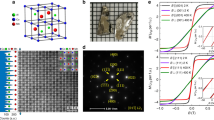Abstract
The nonlinear Hall effect (NLHE), the phenomenon in which a transverse voltage can be produced without a magnetic field, provides a potential alternative for rectification or frequency doubling1,2. However, the low-temperature detection of the NLHE limits its applications3,4. Here, we report the room-temperature NLHE in a type-II Weyl semimetal TaIrTe4, which hosts a robust NLHE due to broken inversion symmetry and large band overlapping at the Fermi level. We also observe a temperature-induced sign inversion of the NLHE in TaIrTe4. Our theoretical calculations suggest that the observed sign inversion is a result of a temperature-induced shift in the chemical potential, indicating a direct correlation of the NLHE with the electronic structure at the Fermi surface. Finally, on the basis of the observed room-temperature NLHE in TaIrTe4 we demonstrate the wireless radiofrequency (RF) rectification with zero external bias and magnetic field. This work opens a door to realizing room-temperature applications based on the NLHE in Weyl semimetals.
This is a preview of subscription content, access via your institution
Access options
Access Nature and 54 other Nature Portfolio journals
Get Nature+, our best-value online-access subscription
$29.99 / 30 days
cancel any time
Subscribe to this journal
Receive 12 print issues and online access
$259.00 per year
only $21.58 per issue
Buy this article
- Purchase on Springer Link
- Instant access to full article PDF
Prices may be subject to local taxes which are calculated during checkout




Similar content being viewed by others
Data availability
The data supporting the findings of this study are available within the paper.
Code availability
The codes that support this study are available from the corresponding author upon reasonable request.
References
Sodemann, I. & Fu, L. Quantum nonlinear Hall effect induced by Berry curvature dipole in time-reversal invariant materials. Phys. Rev. Lett. 115, 216806 (2015).
Isobe, H., Xu, S. Y. & Fu, L. High-frequency rectification via chiral Bloch electrons. Sci. Adv. 6, eaay2497 (2020).
Ma, Q. et al. Observation of the nonlinear Hall effect under time-reversal-symmetric conditions. Nature 565, 337–342 (2019).
Kang, K., Li, T., Sohn, E., Shan, J. & Mak, K. F. Nonlinear anomalous Hall effect in few-layer WTe2. Nat. Mater. 18, 324–328 (2019).
Xiao, D., Chang, M.-C. & Niu, Q. Berry phase effects on electronic properties. Rev. Mod. Phys. 82, 1959–2007 (2010).
Du, Z. Z., Wang, C. M., Lu, H.-Z. & Xie, X. C. Band signatures for strong nonlinear Hall effect in bilayer WTe2. Phys. Rev. Lett. 121, 266601 (2018).
Nagaosa, N., Sinova, J., Onoda, S., MacDonald, A. H. & Ong, N. P. Anomalous Hall effect. Rev. Mod. Phys. 82, 1539–1592 (2010).
Yasuda, K. et al. Geometric Hall effects in topological insulator heterostructures. Nat. Phys. 12, 555–559 (2016).
Pacchioni, G. The Hall effect goes nonlinear. Nat. Rev. Mater. 4, 514 (2019).
Avci, C. O. et al. Unidirectional spin Hall magnetoresistance in ferromagnet/normal metal bilayers. Nat. Phys. 11, 570–575 (2015).
He, P. et al. Bilinear magnetoelectric resistance as a probe of three-dimensional spin texture in topological surface states. Nat. Phys. 14, 495–499 (2018).
Ideue, T. et al. Bulk rectification effect in a polar semiconductor. Nat. Phys. 13, 578–583 (2017).
Low, T., Jiang, Y. & Guinea, F. Topological currents in black phosphorus with broken inversion symmetry. Phys. Rev. B 92, 235447 (2015).
Facio, J. I. et al. Strongly enhanced Berry dipole at topological phase transitions in BiTeI. Phys. Rev. Lett. 121, 246403 (2018).
You, J.-S., Fang, S., Xu, S.-Y., Kaxiras, E. & Low, T. Berry curvature dipole current in the transition metal dichalcogenides family. Phys. Rev. B 98, 121109 (2018).
Zhang, Y., Sun, Y. & Yan, B. Berry curvature dipole in Weyl semimetal materials: an ab initio study. Phys. Rev. B 97, 041101 (2018).
Sipe, J. E. & Shkrebtii, A. I. Second-order optical response in semiconductors. Phys. Rev. B 61, 5337–5352 (2000).
Moore, J. E. & Orenstein, J. Confinement-induced Berry phase and helicity-dependent photocurrents. Phys. Rev. Lett. 105, 026805 (2010).
Morimoto, T. & Nagaosa, N. Topological nature of nonlinear optical effects in solids. Sci. Adv. 2, e1501524 (2016).
Wan, X., Turner, A. M., Vishwanath, A. & Savrasov, S. Y. Topological semimetal and Fermi-arc surface states in the electronic structure of pyrochlore iridates. Phys. Rev. B 83, 205101 (2011).
Armitage, N. P., Mele, E. J. & Vishwanath, A. Weyl and Dirac semimetals in three-dimensional solids. Rev. Mod. Phys. 90, 015001 (2018).
Ma, J. et al. Nonlinear photoresponse of type-II Weyl semimetals. Nat. Mater. 18, 476–481 (2019).
Wu, Y. et al. Temperature-induced Lifshitz transition in WTe2. Phys. Rev. Lett. 115, 166602 (2015).
Koepernik, K. et al. TaIrTe4: a ternary type-II Weyl semimetal. Phys. Rev. B 93, 201101 (2016).
Haubold, E. et al. Experimental realization of type-II Weyl state in noncentrosymmetric TaIrTe4. Phys. Rev. B 95, 241108 (2017).
Belopolski, I. et al. Signatures of a time-reversal symmetric Weyl semimetal with only four Weyl points. Nat. Commun. 8, 942 (2017).
Liu, Y. et al. Raman signatures of broken inversion symmetry and in‐plane anisotropy in type‐II Weyl semimetal candidate TaIrTe4. Adv. Mater. 30, 1706402 (2018).
Mar, A., Jobic, S. & Ibers, J. A. Metal–metal vs tellurium–tellurium bonding in WTe2 and its ternary variants TaIrTe4 and NbIrTe4. J. Am. Chem. Soc. 114, 8963–8971 (1992).
He, P. et al. Nonlinear magnetotransport shaped by Fermi surface topology and convexity. Nat. Commun. 10, 1290 (2019).
Du, Z. Z., Wang, C. M., Li, S., Lu, H.-Z. & Xie, X. C. Disorder-induced nonlinear Hall effect with time-reversal symmetry. Nat. Commun. 10, 3047 (2019).
Lai, J. et al. Broadband anisotropic photoresponse of the “hydrogen atom” version type-II Weyl semimetal candidate TaIrTe4. ACS Nano 12, 4055–4061 (2018).
Acknowledgements
This research was supported by the SpOT-LITE programme (A*STAR grant no. 18A6b0057) through RIE2020 funds from Singapore and Singapore Ministry of Education AcRF Tier 1 (R-263-000-D61-114). P.Y. was supported by the ‘100 Top Talents Program’ of Sun Yat-sen University (no. 29000-18841216) and the ‘Young-teacher Training Program’ of Sun Yat-sen University (no. 29000-31610036). C.-H.H. and G.L. were supported by MOE-AcRF Tier-II: MOE2017-T2-1-114. G.E. acknowledges support from the Ministry of Education (MOE), Singapore, under AcRF Tier 2 (MOE2017-T2-1-134). T.-R.C. was supported by MOST109-2636-M-006-002 and MOST107-2627-E-006-001, National Cheng Kung University, Taiwan, and the National Center for Theoretical Sciences, Taiwan.
Author information
Authors and Affiliations
Contributions
D.K. designed the experimental study, fabricated devices and performed electrical measurements. C.-H.H. and G.L. did simulations and theoretical analyses. R.S. helped in energy-harvesting experiments. T.-R.C. provided the tight-binding models. P.Y. provided single crystals of TaIrTe4. J.W. and G.E. conducted Raman measurements. All authors discussed the results and commented on the manuscript. D.K., C.-H.H. and H.Y. wrote the manuscript. H.Y. initiated the idea and led the project.
Corresponding author
Ethics declarations
Competing interests
The authors declare no competing interests.
Additional information
Peer review information Nature Nanotechnology thanks Hai-Zhou Lu and the other, anonymous, reviewer(s) for their contribution to the peer review of this work.
Publisher’s note Springer Nature remains neutral with regard to jurisdictional claims in published maps and institutional affiliations.
Supplementary information
Supplementary Information
Supplementary Notes 1–13, Figs. 1–10, Table 1 and refs. 1–21.
Rights and permissions
About this article
Cite this article
Kumar, D., Hsu, CH., Sharma, R. et al. Room-temperature nonlinear Hall effect and wireless radiofrequency rectification in Weyl semimetal TaIrTe4. Nat. Nanotechnol. 16, 421–425 (2021). https://doi.org/10.1038/s41565-020-00839-3
Received:
Accepted:
Published:
Issue Date:
DOI: https://doi.org/10.1038/s41565-020-00839-3
This article is cited by
-
Nonlinear transport and radio frequency rectification in BiTeBr at room temperature
Nature Communications (2024)
-
Real space characterization of nonlinear hall effect in confined directions
npj Computational Materials (2024)
-
A tunable room-temperature nonlinear Hall effect in elemental bismuth thin films
Nature Electronics (2024)
-
Relativistic and nonrelativistic Landau levels for the noncommutative quantum Hall effect with anomalous magnetic moment in a conical Gödel-type spacetime
General Relativity and Gravitation (2024)
-
Dual quantum spin Hall insulator by density-tuned correlations in TaIrTe4
Nature (2024)



